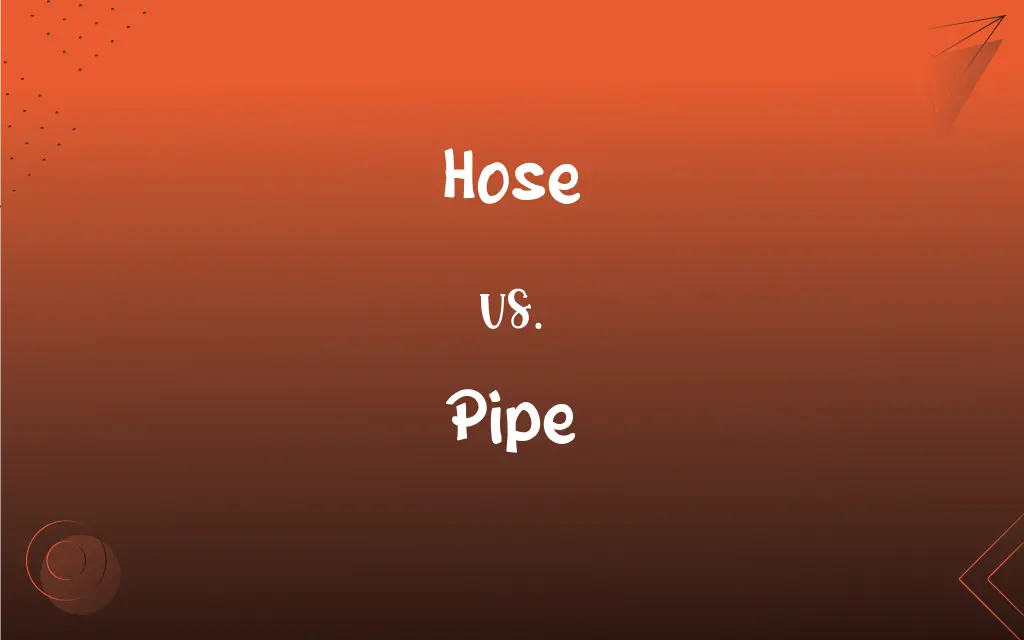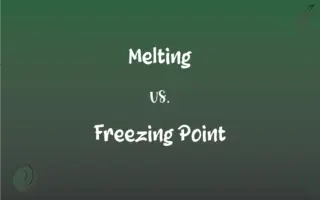Hose vs. Pipe: What's the Difference?
Edited by Aimie Carlson || By Janet White || Published on December 27, 2023
A hose is a flexible tube for conveying fluids, while a pipe is a rigid tube typically used for transporting water, gas, or other substances.

Key Differences
A hose is a flexible, often reinforced, tube used for moving liquids or gases under pressure, adaptable to various shapes and environments. In contrast, a pipe is a rigid, usually cylindrical conduit, often made of metal or plastic, used for the long-term conveyance of substances.
Hoses are designed for mobility and can be easily coiled or maneuvered, ideal for temporary applications like gardening or firefighting. Pipes, on the other hand, are typically fixed in place, forming a permanent part of plumbing or industrial systems.
The material of a hose is usually rubber or flexible plastic, allowing it to bend and flex without breaking. Pipes are made from more durable materials like PVC, steel, or copper, to withstand constant pressure and environmental conditions.
Hoses often come with various attachments or nozzles for different applications, making them versatile for specific tasks. Pipes, however, are generally uniform in design and are used to create stable, long-lasting networks for fluid transport.
The maintenance of hoses involves regular checks for leaks or wear due to their flexibility and exposure to movement. Pipe systems, however, require less frequent maintenance but often necessitate more complex repair procedures due to their fixed nature.
ADVERTISEMENT
Comparison Chart
Flexibility
Flexible and adaptable
Rigid and fixed
Material
Often rubber or flexible plastic
Commonly PVC, steel, or copper
Use
Ideal for temporary or mobile applications
Used in permanent installations
Design Features
Can have attachments like nozzles
Uniform, standardized design
Maintenance and Durability
Requires regular checks for wear
Less frequent maintenance, more durable
ADVERTISEMENT
Hose and Pipe Definitions
Hose
A flexible tube for transporting fluids.
He used a hose to water the garden.
Pipe
A cylindrical conduit made of metal or plastic.
Gas is transported through large underground pipes.
Hose
A tube that can be easily moved and manipulated.
The vacuum cleaner came with a long, flexible hose.
Pipe
A fixed installation for fluid or gas transport.
The factory's cooling system uses a network of steel pipes.
Hose
A portable conduit for fluid transfer.
We connected a hose to the tap to fill the pool.
Pipe
A conduit often used in long-term infrastructure.
The city replaced old sewer pipes to improve sanitation.
Hose
A rubber or plastic tube for conveying gases or liquids.
The fire brigade used a hose to extinguish the fire.
Pipe
A rigid tube for conveying water, gas, or other substances.
The plumber repaired the broken water pipe.
Hose
A flexible pipe often used in gardening or firefighting.
She rolled up the garden hose after watering the plants.
Pipe
A durable tube used in plumbing and construction.
They installed new copper pipes during the renovation.
Hose
Pl. hose Stockings; socks. Used only in the plural.
Pipe
A hollow cylinder or tube used to conduct a liquid, gas, or finely divided solid.
Hose
Close-fitting breeches or leggings reaching up to the hips and fastened to a doublet, formerly worn by men. Used only in the plural.
Pipe
A section or piece of such a tube.
Hose
Breeches reaching down to the knees. Used only in the plural.
FAQs
What is a pipe?
A rigid tube for transporting water, gas, or other substances.
What is a hose?
A flexible tube for moving liquids or gases.
What materials are used for pipes?
Usually PVC, steel, copper, or other durable materials.
Where are hoses commonly used?
In gardening, firefighting, and temporary applications.
Can pipes bend like hoses?
No, pipes are rigid and cannot bend like hoses.
Can hoses be used for long-term installations?
They are not ideal for long-term use due to their flexibility.
How is a hose maintained?
By checking for leaks, wear, and damage regularly.
What are the common uses of pipes?
In plumbing, construction, and permanent installations.
What materials are hoses made of?
Often rubber or flexible plastic.
Do hoses come with attachments?
Yes, like nozzles or sprayers for different uses.
Do pipes have attachments?
Pipes can be fitted with valves and joints, but they're less versatile than hose attachments.
Are hoses durable?
They are less durable than pipes and need regular checks.
Can hoses be used indoors?
Yes, but they're more commonly used outdoors.
Are pipes portable?
No, they are usually fixed and not portable.
Are pipes used indoors?
Yes, pipes are widely used in indoor plumbing and heating systems.
How are pipes maintained?
Through less frequent checks, focusing on joint integrity and blockages.
Can hoses withstand high pressure?
Some hoses are designed for high pressure, but they're generally less pressure-tolerant than pipes.
Is special equipment needed to install pipes?
Often, as pipe installation can be more complex.
Are pipes better for high-pressure applications?
Yes, pipes are better suited for high-pressure situations.
Is a hose easier to install than a pipe?
Yes, due to its flexibility and portability.
About Author
Written by
Janet WhiteJanet White has been an esteemed writer and blogger for Difference Wiki. Holding a Master's degree in Science and Medical Journalism from the prestigious Boston University, she has consistently demonstrated her expertise and passion for her field. When she's not immersed in her work, Janet relishes her time exercising, delving into a good book, and cherishing moments with friends and family.
Edited by
Aimie CarlsonAimie Carlson, holding a master's degree in English literature, is a fervent English language enthusiast. She lends her writing talents to Difference Wiki, a prominent website that specializes in comparisons, offering readers insightful analyses that both captivate and inform.






































































